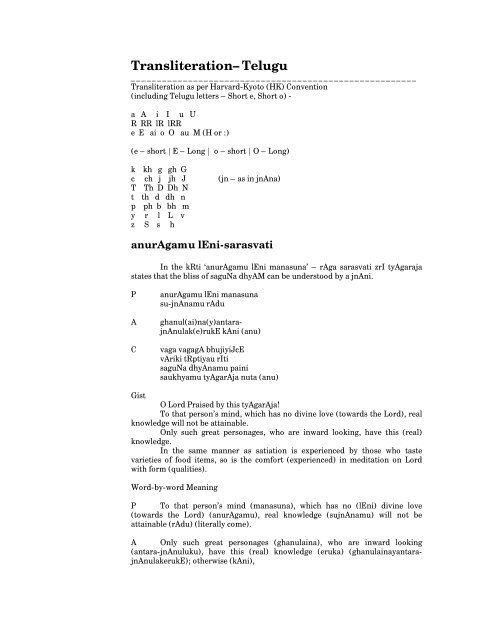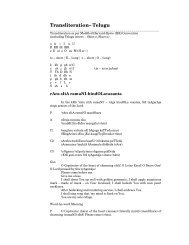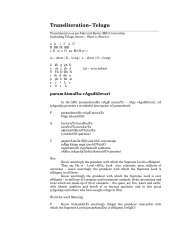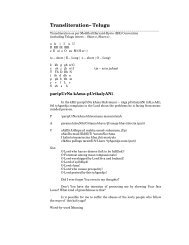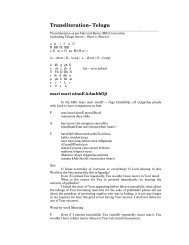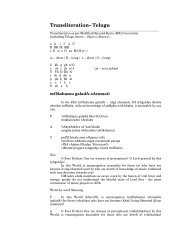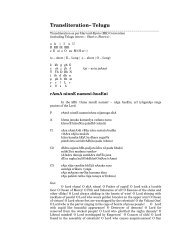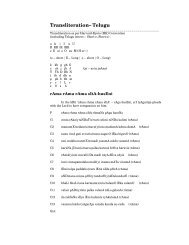TransliterationâTelugu - Gaanapriya
TransliterationâTelugu - Gaanapriya
TransliterationâTelugu - Gaanapriya
Create successful ePaper yourself
Turn your PDF publications into a flip-book with our unique Google optimized e-Paper software.
Transliteration–Telugu<br />
_______________________________________________________<br />
Transliteration as per Harvard-Kyoto (HK) Convention<br />
(including Telugu letters – Short e, Short o) -<br />
a A i I u U<br />
R RR lR lRR<br />
e E ai o O au M (H or :)<br />
(e – short | E – Long | o – short | O – Long)<br />
k kh g gh G<br />
c ch j jh J (jn – as in jnAna)<br />
T Th D Dh N<br />
t th d dh n<br />
p ph b bh m<br />
y r l L v<br />
z S s h<br />
anurAgamu lEni-sarasvati<br />
In the kRti ‘anurAgamu lEni manasuna’ – rAga sarasvati zrI tyAgaraja<br />
states that the bliss of saguNa dhyAM can be understood by a jnAni.<br />
P<br />
A<br />
C<br />
anurAgamu lEni manasuna<br />
su-jnAnamu rAdu<br />
ghanul(ai)na(y)antarajnAnulak(e)rukE<br />
kAni (anu)<br />
vaga vagagA bhujiyiJcE<br />
vAriki tRptiyau rIti<br />
saguNa dhyAnamu paini<br />
saukhyamu tyAgarAja nuta (anu)<br />
Gist<br />
O Lord Praised by this tyAgarAja!<br />
To that person’s mind, which has no divine love (towards the Lord), real<br />
knowledge will not be attainable.<br />
Only such great personages, who are inward looking, have this (real)<br />
knowledge.<br />
In the same manner as satiation is experienced by those who taste<br />
varieties of food items, so is the comfort (experienced) in meditation on Lord<br />
with form (qualities).<br />
Word-by-word Meaning<br />
P To that person’s mind (manasuna), which has no (lEni) divine love<br />
(towards the Lord) (anurAgamu), real knowledge (sujnAnamu) will not be<br />
attainable (rAdu) (literally come).<br />
A Only such great personages (ghanulaina), who are inward looking<br />
(antara-jnAnuluku), have this (real) knowledge (eruka) (ghanulainayantarajnAnulakerukE);<br />
otherwise (kAni),
to that person’s mind which has no divine love, real knowledge will not<br />
be attainable.<br />
C In the same manner (rIti) as satiation is experienced (tRptiyau) by those<br />
(vAriki) who taste (bhujiyiJcu) (literally eat) varieties (vaga vagagA) of food<br />
items,<br />
so is the comfort (saukhyamu) (experienced) in (paini) (literally on)<br />
meditation (dhyanamu) on Lord with form (qualities) (sa-guNa);<br />
O Lord Praised by this tyAgarAja! real knowledge cannot be attained by<br />
one in whose mind there is not divine love towards the Lord.<br />
Notes –<br />
P – anurAgamu - The following couplet from nArada bhakti sUtra is<br />
relevant –<br />
sA tvasmin paramaprEmarUpA || 2 ||<br />
amRtasvarUpA ca || 3 ||<br />
yallabdhvA pumAN siddhO bhavati<br />
amRtO bhavati tRptO bhavati || 4 ||<br />
yat jnAtvA mattO bhavati stabdhO bhavati<br />
AtmArAmO bhavati || 6 ||<br />
anirvacanIyaM prEmasvarUpaM || 51 ||<br />
tat prApya tadEva avalOkati tadEva zruNOti<br />
tadEva bhASayati tadEva cintayati || (55) ||<br />
“That (Divine Love) is of the nature of supreme Love of God.(2) And in<br />
its own intrinsic nature, Divine Love is nothing less than the immortal bliss of<br />
freedom (mukti) itself, which comes unsolicited by the grace of God and by selfsacrifice.(3)<br />
Gaining that, man realises his perfection and divinity and becomes<br />
thoroughly contended.(4) Realising that, man becomes intoxicated and<br />
fascinated, as it were, because he is completely immersed in the enjoyment of the<br />
bliss of the Atman, the truest and highest self.(6) The intrinsic nature of love is<br />
incapable of being described precisely.(51) Attaining that (prEma svarUpaM –<br />
intrinsic nature of Love) one sees and hears only that and thinks only that.”(55)<br />
(Translation by Swami Tyagaisananda)<br />
Ramakrishna Paramahamsa illustrates ‘single minded love’ (anurAga)<br />
through a story about Hanuman. “Once Hanuman came to Dwaraka and wanted<br />
to see Sita and Rama. Krishna said to Rukmini, His queen, ‘You had better<br />
assume the form of Sita; otherwise there will be no escape from the hands of<br />
Hanuman” (because Rama and Sita were Hanuman’s chosen ideals).<br />
A – antara-jnAnulaku – this is how it is given in the book of CR and ATK.<br />
However, in the books of TKG and TSV/AKG, it is given as ‘antar-jnAnulaku’. As<br />
per Sanskrit Dictionary, ‘antarajna’ is the appropriate form. This needs to be<br />
checked. Any suggestions ???<br />
A – eruka – Same as ‘su-jnAna’ given in pallavi.<br />
C – saguNa dhyAnamu paini saukhyamu – The satiation experienced by<br />
the one who tasted varieties of food items cannot be expressed; so also the<br />
comfort derived from the meditation on the Lord with form (qualities) cannot be<br />
expressed. It is only to be experienced. Please see nArada bhakti sUtra - zlOka 4 –<br />
‘tRptO bhavati’ (contended) – and zlOka 51 - ‘anirvacanIyaM’ – (not possible to<br />
describe).<br />
Devanagari<br />
{É. +xÉÖ®úÉMɨÉÖ äôÊxÉ<br />
¨ÉxɺÉÖxÉ ºÉÖ-YÉÉxɨÉÖ ®úÉnÖù
+. PÉxÉÖèôxÉ(ªÉ)xiÉ®ú-<br />
YÉÉxÉÖô(Eäò)¯ûEäò EòÉÊxÉ (+)<br />
SÉ. ´ÉMÉ ´ÉMÉMÉÉ ¦ÉÖÊVÉʪɈÉä<br />
´ÉÉÊ®úÊEò iÉÞʔɪÉÉè ®úÒÊiÉ<br />
ºÉ-MÉÖhÉ vªÉÉxɨÉÖ {ÉèÊxÉ<br />
ºÉÉèJªÉ¨ÉÖ iªÉÉMÉ®úÉVÉ xÉÖiÉ (+)<br />
English with Special Characters<br />
pa. anur¡gamu l®ni<br />
manasuna su-jμ¡namu r¡du<br />
a. ghanulaina(ya)ntarajμ¡nula(ke)ruk®<br />
k¡ni (a)<br />
ca. vaga vagag¡ bhujiyiμc®<br />
v¡riki t¤ptiyau r¢ti<br />
sa-gu¸a dhy¡namu paini<br />
saukhyamu ty¡gar¡ja nuta (a)<br />
Telugu<br />
xms. @©«sVLSgRiª«sVV ÛÍÁ[¬s<br />
ª«sV©«sxqsV©«s xqsVcÇìØ©«sª«sVV LSμRV<br />
@. xmnsV©«sV\ÛÍÁ©«s(¸RV)©«sòLRic<br />
ÇìØ©«sVÌÁ(ZNP)LRiVZNP[ NS¬s (@)<br />
¿RÁ. ª«sgRi ª«sgRigS ˳ÏÁVÑÁLiVV¹ÄÁ[è<br />
ªyLjiNTP »R½Xzmsò¸R° Lki¼½<br />
xqscgRiVßá μ³yù©«sª«sVV \|ms¬s<br />
r¢ÅÁùª«sVV »yùgRiLSÇÁ ©«sV»R½ (@)<br />
Tamil<br />
T. AàWôL 3 Ø úX²<br />
U]^÷] ^÷þOô]Ø WôÕ 3<br />
A. L 4 àûX](V)kRWþ<br />
OôàX(ùL)ÚúL Lô² (A)<br />
N. YL 3 YL 3 Lô 3 × 4´«gúN<br />
Yô¬¡ jÚl§ùVü ç
^þÏQ j 4 Vô]Ø ûT²<br />
ù^üd 2 VØ jVôL 3 Wô_ ÖR (A)<br />
AàWôLUt\ U]j§²p<br />
ùUngOô]m úRôu\ôÕ<br />
Nôuú\ôWô¡V EsúSôdÏûP<br />
úVôÚdÏj ùR¬úYVu±<br />
AàWôLUt\ U]j§²p<br />
ùUngOô]m úRôu\ôÕ<br />
YûL YûLVôL (EQÜ) AÚkÕúYôÚdÏ<br />
¨û\ÜiPôYÕ úTôÛm<br />
NÏQ §Vô]j§²p ùNüd¡VØm;<br />
§VôLWôN]ôp úTôt\l ùTtú\ôú]!<br />
AàWôLUt\ U]j§²p<br />
ùUngOô]m úRôu\ôÕ<br />
AàWôLm þ Cû\Y²Pm BrkR LôRp<br />
EsúSôdÏ þ AhPôeL úVôLØû\ Aàh¥jRp<br />
ùR¬Ü þ ùUngOô]m<br />
NÏQj §Vô]m þ Cû\Yû] EÚYjÕPu §Vô²jRp<br />
¨oÏQj §Vô]m þ Cû\Yû] AÚYUôLj §Vô²jRp<br />
AhPôeL úVôLm þ Øû\úV þ CVUm, ¨VUm, BR]m,<br />
©WôQôVôUm, ©Wj§VôLôWm, RôWûQ, §Vô]m, NUô§<br />
CVU ¨VUúU Gi¦Xô BR]m<br />
SVØß ©WôQôVô Um ©Wj§ VôLôWg<br />
NVªÏ RôWûQ §Vô]g NUô§<br />
AVØßm AhPôeL UôYÕ UôúU þ §ÚUk§Wm þ 552<br />
Kannada<br />
®Ú. @«ÚßÁÛVÚÈÚßß ÅæÞ¬<br />
ÈÚß«ÚÑÚß«Ú ÑÚß-eÛk«ÚÈÚßß ÁÛ¥Úß<br />
@. YÚ«ÚßÅæç«Ú(¾Úß)«Ú¡ÁÚeÛk«ÚßÄ(Oæ)ÁÚßOæÞ<br />
OÛ¬ (@)<br />
^Ú. ÈÚVÚ ÈÚVÚVÛ ºÚßf¿ßjÜæ`Þ<br />
ÈÛÂP }Ú䯡¾Úáè ÂÞ~<br />
ÑÚ-VÚßy ¨ÛÀ«ÚÈÚßß ®æç¬<br />
ÑèRÀÈÚßß }ÛÀVÚÁÛd «Úß}Ú (@)
Malayalam<br />
]. A\pcmKap te\n<br />
a\kp\ kpþÚm\ap cmZp<br />
A. L\psse\(b)´cþ<br />
Úm\pe(sI)cptI Im\n (A)<br />
N. hK hKKm `pPnbnt©<br />
hmcnIn Xr]vXnbu coXn<br />
kþKpW [ym\ap ss]\n<br />
kuJyap XymKcmP \pX (A)<br />
Assamese<br />
Y. %XÇ»çG]Ç å_×X<br />
]XaÇX aÇ-pûçX]Ç »çVÇ<br />
%. HXÇê_X(Ì^)Üö»-<br />
pûçXÇ_(åEõ)»ÓãEõ Eõç×X (%)<br />
$Jô. ¾G ¾GGç \Çö×L×Ì^ã‡û<br />
¾ç×»×Eõ TÊö׊ãÌ^ì »Ý×Tö<br />
a-mS WýËÌ^çX]Ç éY×X<br />
åaìFËÌ^]Ç ±Ì^çG»çL XÇTö (%)<br />
Bengali<br />
Y. %XÇÌ[ýçG]Ç å_×X<br />
]XaÇX aÇ-pûçX]Ç Ì[ýçVÇ<br />
%. HXÇê_X(Ì^)ÜöÌ[ýpûçXÇ_(åEõ)Ì[ýÓãEõ<br />
Eõç×X (%)<br />
»Jô. [ýG [ýGGç \Çö×L×Ì^ã‡û<br />
[ýç×Ì[ý×Eõ TÊö׊ãÌ^ì Ì[ýÝ×Tö<br />
a-mS WýËÌ^çX]Ç éY×X<br />
åaìFËÌ^]Ç ±Ì^çGÌ[ýçL XÇTö (%)<br />
Gujarati<br />
~É. +{ÉÖ−÷ÉNÉ©ÉÖ ±ÉàÊ{É
©É{É»ÉÖ{É »ÉÖ-[ÉÉ{É©ÉÖ −÷ÉqÖö<br />
+. PÉ{ÉÖ±Éä{É(«É){lÉ−÷-<br />
[ÉÉ{ÉÖ±É(Hèí)®øHàí HíÉÊ{É (+)<br />
SÉ. ´ÉNÉ ´ÉNÉNÉÉ §ÉÖÊWðÊ«É_SÉà<br />
´ÉÉÊ−÷ÊHí lÉÞÎ~lÉ«ÉÉä −÷ÒÊlÉ<br />
»É-NÉÖiÉ y«ÉÉ{É©ÉÖ ~ÉäÊ{É<br />
»ÉÉäL«É©ÉÖ l«ÉÉNÉ−÷ÉWð {ÉÖlÉ (+)<br />
Oriya<br />
`. @_ÊeþÐNcÊ Òmþ_Þ<br />
c_jÊ_ jÊ-sÐ_cÊ eþÐ]Ê<br />
@. O_ÊÒmßþ_(¯Æ)«ÆeþsÐ_Êmþ(ÒL)eÊþÒL<br />
LÐ_Þ (@)<br />
Q. gN gNNÐ bÊþSÞ¯ÞÆÒq<br />
gÐeÞþLÞ [ó©ÞÆÒ¯Æ× eþÑ[Þ<br />
j-NÊZ ^ÔÐ_cÊ Ò`ß_Þ<br />
Òj×MÔcÊ [ÔÐNeþÐS _Ê[ (@)<br />
Punjabi<br />
a. A`xjsIgx k~u`<br />
g`nx` nx-uIAs`gx js]x<br />
A. K`xk¤`(h)`YjuIAs`xk(E~)jxE~<br />
Esu` (A)<br />
M. mI mIIs exuOuhRM~<br />
msujuE uZuaYh¬ jvuY<br />
n-IxX _is`gx a¤u`<br />
n¬Gigx YisIjsO `xY (A)


